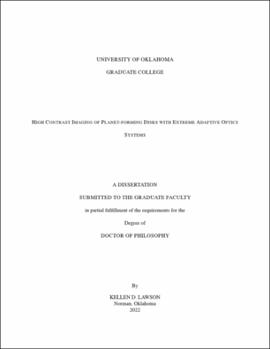| dc.description.abstract | Circumstellar disks serve as benchmark systems to study how and where exoplanets form. With the advent of ground-based extreme adaptive optics (AO) facilities, we have entered a revolutionary era for disk studies. It is now feasible to simultaneously resolve the structures within disks that could be caused by planets and directly identify the young companions that may induce them. The use of integral field spectrographs (IFSs) --- which provide images at an array of wavelengths --- enhances this capability by helping to characterize disk material and any identified companions.
Using data from Subaru's extreme AO system, SCExAO, paired with the CHARIS IFS, we present near-infrared (NIR) observations of two systems hosting debris disks --- gas-poor, dusty disks at the end stages of planetary system formation. For HD 15115, we introduce the use of differential evolution (DE) for disk model optimization --- which finds a strong solution while evaluating many fewer models than common alternatives. From modeling, we find no evidence to support the presence of a (possibly planet-driven) misaligned inner-ring as was suggested previously. For the HD 36546 system, we show its disk has either an extremely shallow radial density profile or a ``back-swept wing profile"; the latter case, combined with the blue NIR color of the disk, could suggest interaction with an unseen planet.
CHARIS recently added a new and unique integral field spectropolarimetry mode which produces high-contrast polarimetry at the same array of wavelengths as its standard IFS mode. We describe the software module which we designed to process data from this observing mode, present preliminary results for two planet-forming disk systems, and provide a summary of investigations enabled by this mode --- including tests on embedded companions.
Finally, we introduce a new technique for removing starlight in imagery of circumstellar disk systems, ``Constrained Reference Star Differential Imaging (RDI)", which uses prior knowledge to more accurately model (and remove) the starlight in a data sequence. Using simulated and on-sky data, we demonstrate the ability of this technique to effectively eliminate the variable loss of circumstellar light that normally occurs as starlight is removed. This enables spatial and spectral analysis of circumstellar disks in unprecedented detail and provides a much clearer path to the robust identification and validation of exoplanets embedded within them. | en_US |
